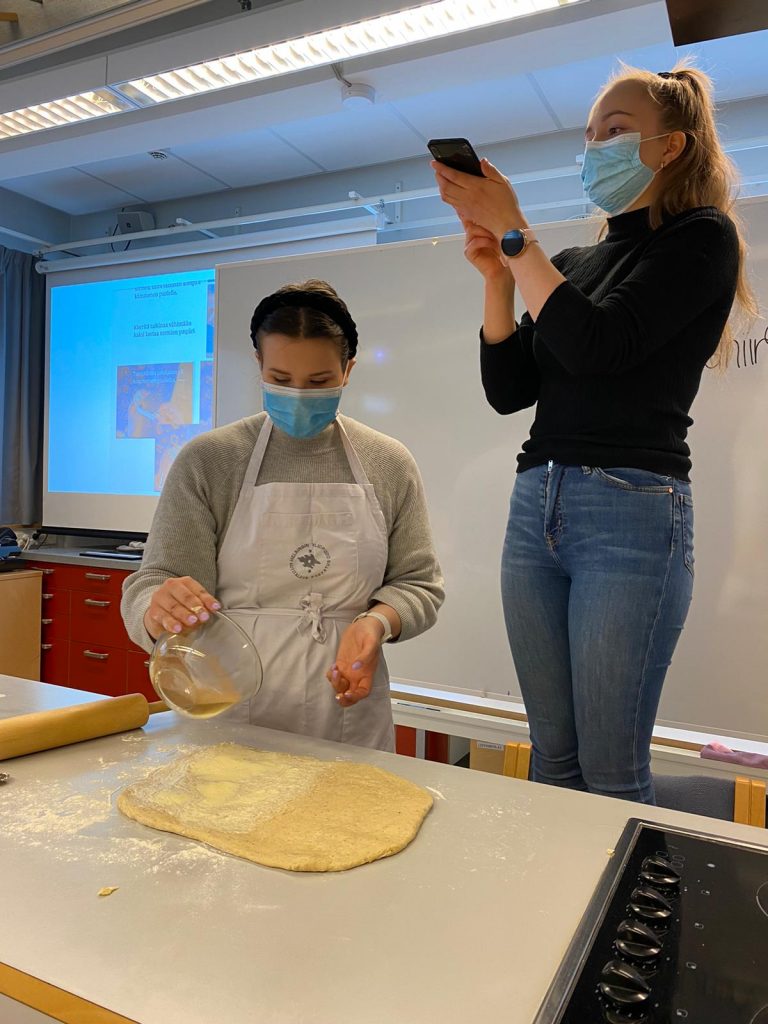Aino Antas, Susanna Lukkari, Vilja Lukkarinen & Noora Nikitin
The purpose of our development work was to design an intervention using distance learning methods related to handicrafts and aesthetics during the pandemic. The aim of the teaching experiment was to organize distance learning in real time using communication technology tools and applications. The subject of the lessons was to recap of what yeast dough is, to make cinnamon rolls and set up a creative food picture. The teaching was organized through co-teaching. In addition, the aim of the course was to implement gender-conscious teaching.
Premises of the teaching experiment
According to the Finnish National Core Curriculum for basic education (2014), one of the aims of Home Economics is to promote handicrafts and creativity (POPS, 2014, 437). The promotion of handicrafts and creativity is relevant to aesthetics and its training in terms of teaching experimentation. T2 guides students to practice their handicrafts needed to manage the household and encourages creativity and attention to aesthetics. (POPS, 2014, 438–439.) More information about aesthetics can be found here.
The pedagogical intervention (or, experiment) was based on a behaviorist approach to learning with elements from the socio-constructivist approach. In schools, the teaching of arts and skills often focuses on the behaviorist concept, as students imitate the models given by the teacher (Räsänen, 2009, 20). Especially distance learning can highlight the characteristics of behaviorism, as the teacher plays a major role in this. On the other hand, according to Rantanen and Palojoki (2015, 89), it is possible to create a framework for learning according to the socio-constructivist approach to online teaching.
In particular, co-operation and interactivity have been seen as good motivational aspects in teaching.
The course of the teaching experiment, technological implementation and learning materials
We chose a school in Northern Finland for the teaching experiment. The teaching was carried out by video connections via Teams between the University of Helsinki and a school in Northern Finland. Two of us were filming the first lesson with a mobile phone for a school in Northern Finland and two of us were teaching.
In the next lesson later that week, we changed roles. We held the lessons through Teams. The lesson was live-streamed on the school board while we were in Helsinki at the university´s classroom. One week before the lessons, we had asked each pupil group to send us a video greeting in which they shared their favorite delicacies and their strength as a group, among other things. We made our own video, where we told about ourselves, for example who we are, why we are teaching the subject and what our favorite delicacies are. We presented the video right at the beginning of the lesson, because, in addition to introducing ourselves, we talked about the goals of the lesson and the technological implementation.
At the beginning of the lesson, we prepared yeast dough together with the pupils. During the lesson, one of our group members used a phone to film how we created our own bun dough. The pupils made bun dough at school at the same time as we did, or slightly behind. We tried to look at their work via video and asked about their working steps so that we could make the dough at the same time.

When the dough was rising, we advised the pupils to do the dishes and we taught about the design of cinnamon rolls with the help of our Canva presentation. We showed our Canva presentation by sharing our laptop’s screen in Teams. In addition to Canva, we showed an illustrative video in which of one of our group member’s brother showed the design of the cinnamon rolls.
All of our group members are females, so we wondered how we could pass the message to the pupils that creating an aesthetic food picture or handicrafts are not gender dependent. The purpose of the video was to break stereotypes and follow a gender-neutral mindset. In this way, the goal of gender-conscious teaching was implemented during the lesson. In addition, during the rise of the dough, we also taught the perspectives related to taking a food picture with the help of a Canva presentation. When taking a food picture, we pointed out the need to select a fitting background, lighting, layout and angle. In addition, we suggested that pupils use, for example, a plate or basket, a napkin and something else in the Home Economics class.

After rising the dough, it was time to shape the buns and put them in the oven. While the buns were baking, we advised pupils to finish their dishes, set the table and prepare the filming location. When we took the buns out of the oven, we reminded pupils to take a great food picture before the moment of delicacy.
We asked if we could use the food pictures that they took in our report anonymously. The pupils gave us permission to use their pictures, when they sent the food picture directly to one of our team member’s email. During the delicacy, we asked the pupils to answer a quick feedback questionnaire about the course of the lesson. This gave us immediate feedback on the process. We finished the lesson while pupils sat peacefully at their tables, because we wanted to give them a peaceful ending of the lesson. We finished the lesson about five minutes before the estimated time.
Assessment of the teaching situation and feedback
The lesson enabled us to give pupils immediate feedback about their work. We experienced this as an important factor in encouraging pupils to enjoy the learning, which strengthens the conditions for creative thinking. At a certain level, providing feedback is about the person’s actions and the different parts related to the work, which therefore affects the recipient’s self-esteem (Syrjäläinen, Jyrhämä & Haverinen, 2008). As a result, we experienced a positive and encouraging touch that motivates students.
The interaction on the pupils’ behalf was limited due to technical reasons, so we wanted to encourage pupils to give feedback anonymously. We used Google Forms to create a feedback form that we could share with the Teams platform.
Reflection on the lesson
The teaching experiment provided us many insights and opportunities for learning new things. The most significant thing we learned as a group was distance learning skills and how we managed to teach the pupils new skills in real time without being physically present. The success of co-operation and interaction remotely was a positive experience, as we were not sure in advance how we would make it work. In addition, the gender-conscious bun design video had greater meaning than we had expected. It also motivated pupils, since the person shown in the video was closer to their age group than us.
Although our teaching experiment included great insights and successes, unpredictable challenges also emerged which we were not prepared for. The biggest challenges for the lessons were the functionality of remote connections and the rise of the bun dough. That’s why we modified the lesson plan for Friday’s lesson. We made starter dough and set more time for potential technological challenges.
Tolerating uncertainty and moving out of our comfort zone played a big role in our teaching experiment. This point highlighted the power of co-teaching when we were able to seek support from members of our group when facing problems. Co-teaching allows equal co-operation between teachers, in which they are responsible for planning, implementing and evaluating learning together. The co-teaching often includes more versatile work and learning content than if the teacher arranges the class alone.
References
Opetushallitus (2014). Perusopetuksen opetussuunnitelman perusteet 2014. Helsinki. Saatavissa: https://www.oph.fi/sites/default/files/documents/perusopetuksen_opetussuunnitelman_perusteet_2014.pdf.
Rantanen, M. & Palojoki, P. (2015). Kotitalous verkko-opetuksena. Teoksessa: Janhonen-Abruquah, H. & Palojoki, P. (toim.) Luova ja vastuullinen kotitalousopetus. Helsingin yliopisto. Käyttäytymistieteellinen tiedekunta.
Räsänen, M. (2009). Taide, taito, tieto – ei kahta ilman kolmatta. Teoksessa Opetushallituksen taide- ja taitokasvatuksen asiantuntijatyöryhmä (toim.) Taide ja taito – kiinni elämässä! (ss. 28–39). Helsinki: Edita Prima Oy.
Kinnunen, A (2000). Estetiikka. Helsinki: WSOY.
